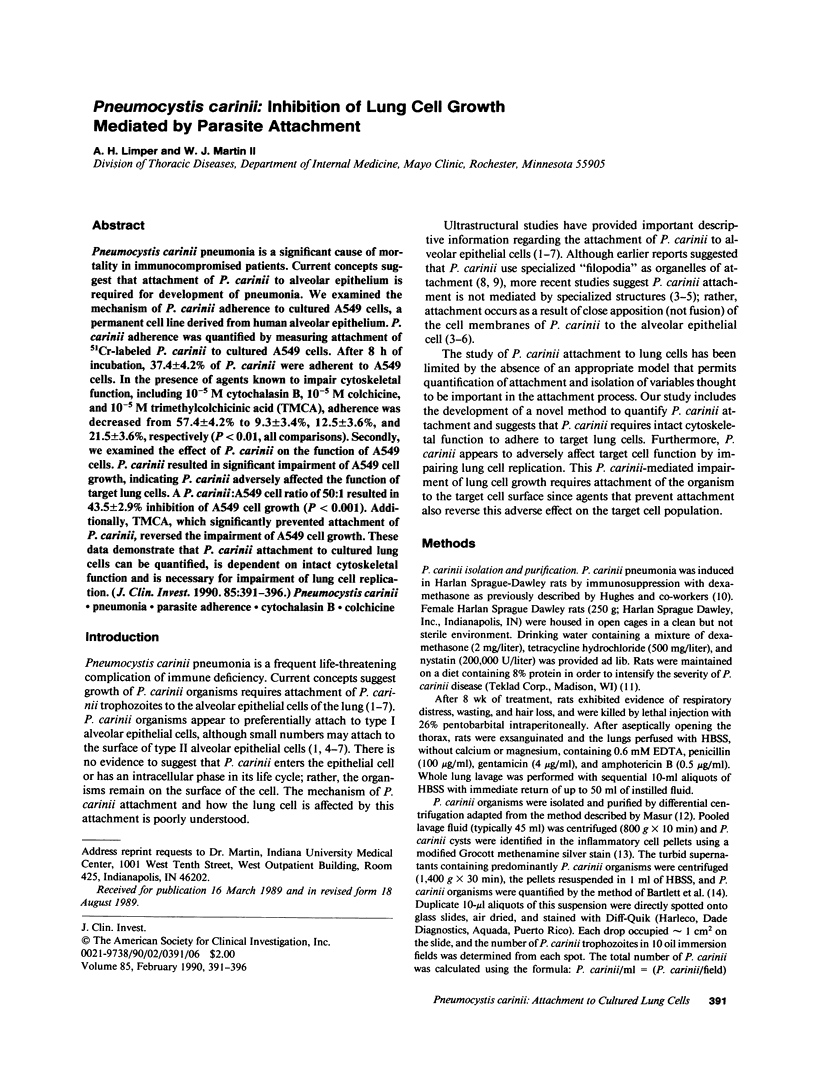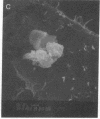Abstract
Pneumocystis carinii pneumonia is a significant cause of mortality in immunocompromised patients. Current concepts suggest that attachment of P. carinii to alveolar epithelium is required for development of pneumonia. We examined the mechanism of P. carinii adherence to cultured A549 cells, a permanent cell line derived from human alveolar epithelium. P. carinii adherence was quantified by measuring attachment of 51Cr-labeled P. carinii to cultured A549 cells. After 8 h of incubation, 37.4 +/- 4.2% of P. carinii were adherent to A549 cells. In the presence of agents known to impair cytoskeletal function, including 10(-5) M cytochalasin B, 10(-5) M colchicine, and 10(-5) M trimethylcolchicinic acid (TMCA), adherence was decreased from 57.4 +/- 4.2% to 9.3 +/- 3.4%, 12.5 +/- 3.6%, and 21.5 +/- 3.6%, respectively (P less than 0.01, all comparisons). Secondly, we examined the effect of P. carinii on the function of A549 cells. P. carinii resulted in significant impairment of A549 cell growth, indicating P. carinii adversely affected the function of target lung cells. A P. carinii:A549 cell ratio of 50:1 resulted in 43.5 +/- 2.9% inhibition of A549 cell growth (P less than 0.001). Additionally, TMCA, which significantly prevented attachment of P. carinii, reversed the impairment of A549 cell growth. These data demonstrate that P. carinii attachment to cultured lung cells can be quantified, is dependent on intact cytoskeletal function and is necessary for impairment of lung cell replication.
Full text
PDF





Images in this article
Selected References
These references are in PubMed. This may not be the complete list of references from this article.
- Bartlett M. S., Verbanac P. A., Smith J. W. Cultivation of Pneumocystis carinii with WI-38 cells. J Clin Microbiol. 1979 Dec;10(6):796–799. doi: 10.1128/jcm.10.6.796-799.1979. [DOI] [PMC free article] [PubMed] [Google Scholar]
- Davies P., Allison A. C. Effects of cytochalasin B on endocytosis and exocytosis. Front Biol. 1978;46:143–160. [PubMed] [Google Scholar]
- Goldman R. D. The effects of cytochalasin B on the microfilaments of baby hamster kidney (BHK-21) cells. J Cell Biol. 1972 Feb;52(2):246–254. doi: 10.1083/jcb.52.2.246. [DOI] [PMC free article] [PubMed] [Google Scholar]
- Ham E. K., Greenberg D., Reynolds R. C., Singer D. B. Ultrastructure of Pneumocystis carinii. Exp Mol Pathol. 1971 Jun;14(3):362–372. doi: 10.1016/0014-4800(71)90007-4. [DOI] [PubMed] [Google Scholar]
- Henshaw N. G., Carson J. L., Collier A. M. Ultrastructural observations of Pneumocystis carinii attachment to rat lung. J Infect Dis. 1985 Jan;151(1):181–186. doi: 10.1093/infdis/151.1.181. [DOI] [PubMed] [Google Scholar]
- Hughes W. T., McNabb P. C., Makres T. D., Feldman S. Efficacy of trimethoprim and sulfamethoxazole in the prevention and treatment of Pneumocystis carinii pneumonitis. Antimicrob Agents Chemother. 1974 Mar;5(3):289–293. doi: 10.1128/aac.5.3.289. [DOI] [PMC free article] [PubMed] [Google Scholar]
- Itatani C. A., Marshall G. J. Ultrastructural morphology and staining characteristics of Pneumocystis carinii in situ and from bronchoalveolar lavage. J Parasitol. 1988 Aug;74(4):700–712. [PubMed] [Google Scholar]
- Johanson W. G., Jr, Higuchi J. H., Chaudhuri T. R., Woods D. E. Bacterial adherence to epithelial cells in bacillary colonization of the respiratory tract. Am Rev Respir Dis. 1980 Jan;121(1):55–63. doi: 10.1164/arrd.1980.121.1.55. [DOI] [PubMed] [Google Scholar]
- Lanken P. N., Minda M., Pietra G. G., Fishman A. P. Alveolar response to experimental Pneumocystis carinii pneumonia in the rat. Am J Pathol. 1980 Jun;99(3):561–588. [PMC free article] [PubMed] [Google Scholar]
- Long E. G., Smith J. S., Meier J. L. Attachment of Pneumocystis carinii to rat pneumocytes. Lab Invest. 1986 Jun;54(6):609–615. [PubMed] [Google Scholar]
- Mahan C. T., Sale G. E. Rapid methenamine silver stain for Pneumocystis and fungi. Arch Pathol Lab Med. 1978 Jul;102(7):351–352. [PubMed] [Google Scholar]
- Malech H. L., Root R. K., Gallin J. I. Structural analysis of human neutrophil migration. Centriole, microtubule, and microfilament orientation and function during chemotaxis. J Cell Biol. 1977 Dec;75(3):666–693. doi: 10.1083/jcb.75.3.666. [DOI] [PMC free article] [PubMed] [Google Scholar]
- Martin W. J., 2nd, Kachel D. L. Oxygen-mediated impairment of human pulmonary endothelial cell growth: evidence for a specific threshold of toxicity. J Lab Clin Med. 1989 Apr;113(4):413–421. [PubMed] [Google Scholar]
- Murphy M. J., Pifer L. L., Hughes W. T. Pneumocystis carinii in vitro: A study by scanning electron microscopy. Am J Pathol. 1977 Feb;86(2):387–401. [PMC free article] [PubMed] [Google Scholar]
- Niederman M. S., Ferranti R. D., Zeigler A., Merrill W. W., Reynolds H. Y. Respiratory infection complicating long-term tracheostomy. The implication of persistent gram-negative tracheobronchial colonization. Chest. 1984 Jan;85(1):39–44. doi: 10.1378/chest.85.1.39. [DOI] [PubMed] [Google Scholar]
- Niederman M. S., Merrill W. W., Ferranti R. D., Pagano K. M., Palmer L. B., Reynolds H. Y. Nutritional status and bacterial binding in the lower respiratory tract in patients with chronic tracheostomy. Ann Intern Med. 1984 Jun;100(6):795–800. doi: 10.7326/0003-4819-100-6-795. [DOI] [PubMed] [Google Scholar]
- Schaeffer A. J., Jones J. M., Dunn J. K. Association of vitro Escherichia coli adherence to vaginal and buccal epithelial cells with susceptibility of women to recurrent urinary-tract infections. N Engl J Med. 1981 Apr 30;304(18):1062–1066. doi: 10.1056/NEJM198104303041802. [DOI] [PubMed] [Google Scholar]
- Tilney L. G. Studies on the microtubules in heliozoa. IV. The effect of colchicine on the formation and maintenance of the axopodia and the redevelopment of pattern in Actinosphaerium nucleofilum (Barrett). J Cell Sci. 1968 Dec;3(4):549–562. doi: 10.1242/jcs.3.4.549. [DOI] [PubMed] [Google Scholar]
- Valberg P. A., Brain J. D., Kane D. Effects of colchicine or cytochalasin B on pulmonary macrophage endocytosis in vivo. J Appl Physiol Respir Environ Exerc Physiol. 1981 Mar;50(3):621–629. doi: 10.1152/jappl.1981.50.3.621. [DOI] [PubMed] [Google Scholar]
- Vavra J., Kucera K. Pneumocystis carinii delanoë, its ultrastructure and ultrastructural affinities. J Protozool. 1970 Aug;17(3):463–483. doi: 10.1111/j.1550-7408.1970.tb04715.x. [DOI] [PubMed] [Google Scholar]
- Wallace S. L. Colchicine and new antiinflammatory drugs for the treatment of acute gout. Arthritis Rheum. 1975 Nov-Dec;18(6 Suppl):847–851. doi: 10.1002/art.1780180730. [DOI] [PubMed] [Google Scholar]
- Walzer P. D. Attachment of microbes to host cells: relevance of Pneumocystis carinii. Lab Invest. 1986 Jun;54(6):589–592. [PubMed] [Google Scholar]
- Walzer P. D., LaBine M., Redington T. J., Cushion M. T. Predisposing factors in Pneumocystis carinii pneumonia: effects of tetracycline, protein malnutrition, and corticosteroids on hosts. Infect Immun. 1984 Dec;46(3):747–753. doi: 10.1128/iai.46.3.747-753.1984. [DOI] [PMC free article] [PubMed] [Google Scholar]
- Yamada K. M., Spooner B. S., Wessells N. K. Axon growth: roles of microfilaments and microtubules. Proc Natl Acad Sci U S A. 1970 Aug;66(4):1206–1212. doi: 10.1073/pnas.66.4.1206. [DOI] [PMC free article] [PubMed] [Google Scholar]
- Yoneda K., Walzer P. D. Attachment of Pneumocystis carinii to type I alveolar cells studied by freeze-fracture electron microscopy. Infect Immun. 1983 May;40(2):812–815. doi: 10.1128/iai.40.2.812-815.1983. [DOI] [PMC free article] [PubMed] [Google Scholar]
- Zakhireh B., Malech H. L. The effect of colchicine and vinblastine on the chemotactic response of human monocytes. J Immunol. 1980 Nov;125(5):2143–2153. [PubMed] [Google Scholar]






